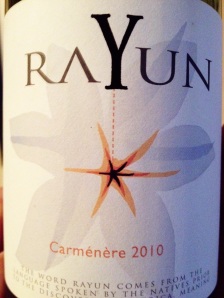 Been awhile since my last post! A lot has happened – my longtime girlfriend Lyndsey and I finally got engaged, we traveled to Guatemala and Belize, and my cat learned how to jump through hoops. So many excellent reasons to party have accumulated that I’ve been too busy partying to post! But the time for delaying is over, and today’s critique concerns an affordable wine that suits just about any dinner party or similar occasion, particularly if you have something to celebrate. Like my life in general, this bottle is full of surprising enjoyments.
Been awhile since my last post! A lot has happened – my longtime girlfriend Lyndsey and I finally got engaged, we traveled to Guatemala and Belize, and my cat learned how to jump through hoops. So many excellent reasons to party have accumulated that I’ve been too busy partying to post! But the time for delaying is over, and today’s critique concerns an affordable wine that suits just about any dinner party or similar occasion, particularly if you have something to celebrate. Like my life in general, this bottle is full of surprising enjoyments.
If you’re looking for a wine to pour with loved ones during Sunday dinner, you’re probably looking for a red that has exactly that right balance of friendly fruit, depth and body. If you’re me, and it’s tonight, you’re having lamb. The ideal wine partner for lamb will generally exhibit a couple of characteristics: dark fruit, earthy or peppery undertones, and nice balance. In other words, you’re looking for Carmenère.
I have described Carmenère’s intriguing history in Chile before, wherein growers often thought they were dealing with Merlot for over a century; it was only formally recognized as a grape variety in 1998. Fortunately for wine drinkers everywhere, production was not discontinued after they discovered otherwise; rather, Chile remains the world’s primary producer of this ancient French relative of Cabernet Sauvignon. Carmenère now grows chiefly in the Colchagua Valley, Rapel Valley, and Maipo Province. In fact, the name ‘Carmenère’ is derived from the French word carmin, meaning crimson. It is indeed a beautiful deep crimson in the glass, and can often be difficult to distinguish from Cabernet or Merlot in blind tastings.
Tonight’s wine, the 2010 Geo Wines Rayun Carmenère, hails from the Rapel Valley. It’s a classic example of what this grape can do in a drier, warmer microclimate. A lovely crimson in color, with aromas of blackcurrants, plum, green bell pepper, and earth. Medium-bodied, lush, with more dark fruit on the mouth tending towards cocoa and earthiness towards the long finish. Really a spectacular value at $11. Pair with any kind of red meat that you’re roasting, and bring friends, family, or loved ones.





